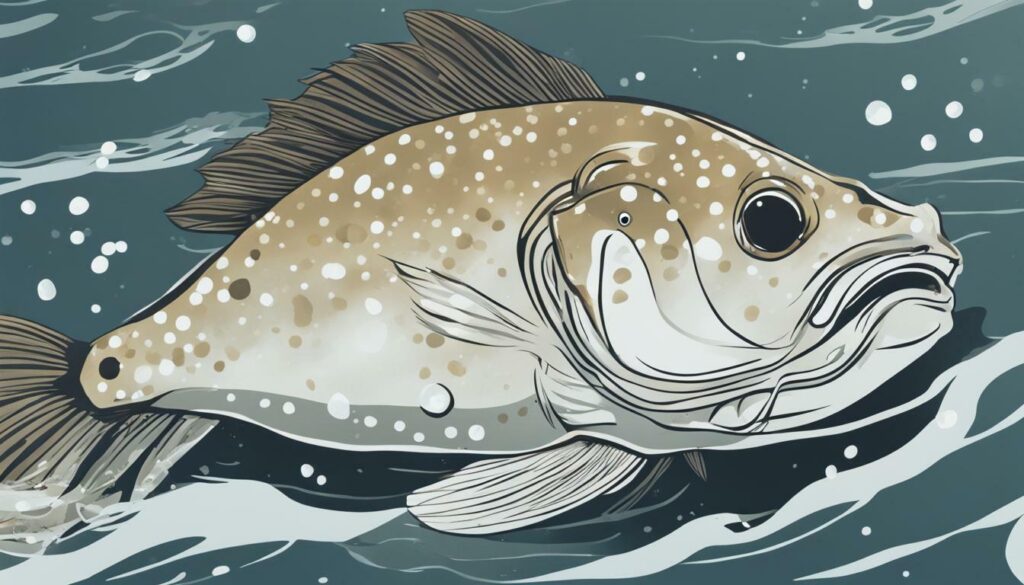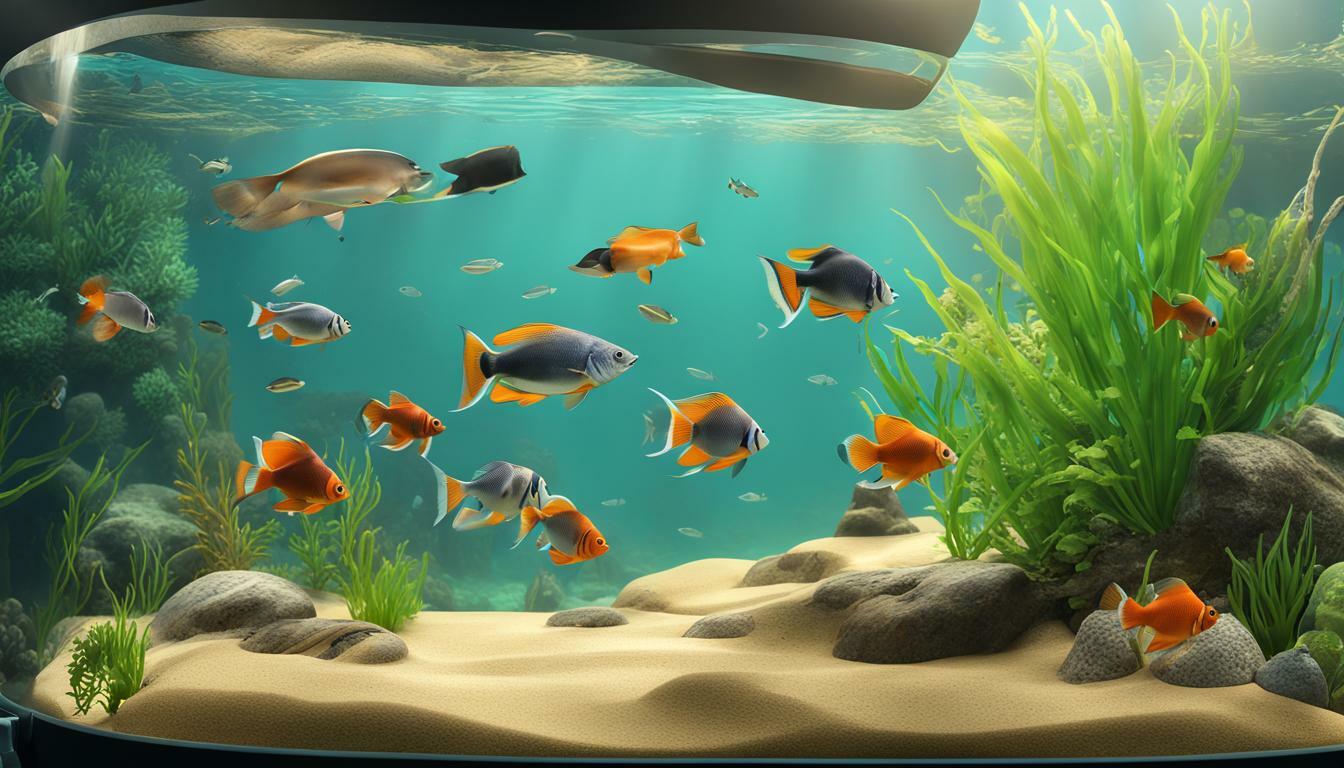As fish owners, we want our aquatic pets to be healthy, happy, and thriving in their habitat. However, seeing our aquarium fish lying on the bottom of the tank can be alarming and concerning. There are various reasons for this behavior, and it’s essential to understand them to ensure our fish’s well-being.
It’s crucial to note that not all fish lying on the tank bottom are experiencing problems. Some species are naturally bottom-dwellers, such as catfish, loaches, and some types of cichlids. But if you notice your fish lying on the bottom for an extended period, it could be a sign of a problem.
Key Takeaways:
- Seeing your aquarium fish lying on the bottom of the tank can be alarming, but it’s essential to understand the reasons why.
- Some species are naturally bottom-dwellers, but prolonged lying on the bottom can indicate a problem.
Understanding Bottom-Dwelling Fish Behavior
Before we delve into the reasons why aquarium fish might lie on the bottom of their tank, let’s first explore the natural behavior of bottom-dwelling fish. Many species of fish actually prefer to spend their time near the substrate of the tank, whether it be sand, gravel, or rocks. This behavior is often associated with their feeding habits, as many bottom-dwelling fish are scavengers that prefer to sift through the substrate for bits of food.
Some common species of bottom-dwelling fish include catfish, loaches, and some types of cichlids. These fish also tend to have specific adaptations that make them well-suited to this type of environment, such as flattened bodies that allow them to easily move along the bottom of the tank.

It’s important to note that not all fish that spend time near the substrate are bottom-dwellers. Some fish might simply be resting or hiding, and it’s up to us as aquarists to monitor their behavior and ensure they are healthy and happy.
Common Causes of Fish Lying on the Tank Floor
When aquarium fish lie on the bottom of the tank, it can be concerning for pet owners. There are several reasons why fish may exhibit this behavior, including:
- Stress: Fish can become stressed due to changes in their environment, such as a new tank, new mates, or loud noises. They may also be stressed by poor water quality or overcrowding.
- Sickness: Illnesses such as swim bladder disease, fin rot, or parasitic infections can cause fish to rest on the tank floor.
- Poor Water Conditions: Ammonia or nitrite buildup in the tank can cause fish to become lethargic and lie on the bottom. High levels of nitrates can also lead to health problems over time.
- Inadequate Oxygen: Oxygen is necessary for fish to thrive, and low levels can cause them to suffer and rest on the bottom of the tank.
Identifying the cause of your fish’s behavior is crucial in finding a solution. If you suspect illness or poor water quality, it’s essential to take action immediately to ensure the health of your fish.

Regular water testing and tank maintenance can help prevent many of these issues from arising. In the next sections, we will explore how to ensure optimal water quality, proper tank setup, and adequate nutrition to keep your fish healthy and happy.
Ensuring Optimal Aquarium Water Quality
Keeping your aquarium water clean and healthy is crucial in preventing fish from lying on the bottom of the tank. Poor water quality can lead to stress, illness, and even death. Here are some tips for maintaining optimal water quality:
- Perform regular water changes: It is recommended to change 10-20% of the water in your aquarium every week to remove excess waste, debris, and toxins.
- Monitor water parameters: Use a test kit to check the levels of ammonia, nitrite, and nitrate in your water. An imbalanced level of these chemicals can be harmful to fish.
- Invest in a good filtration system: A filtration system helps to remove waste, excess food, and toxins from the water. Be sure to choose a filter appropriate for the size of your tank and the type of fish you have.
- Avoid overfeeding: Overfeeding can lead to excess waste which can negatively impact water quality. Feed your fish a small amount of food once or twice a day and remove any uneaten food after a few minutes.
Keeping your aquarium water clean and healthy is essential in ensuring your fish remain happy and healthy. By implementing regular maintenance routines and monitoring water quality, you can prevent fish from lying on the bottom of the tank due to poor water conditions.

Proper Tank Setup for Bottom-Feeders
If you have bottom-dwelling fish in your aquarium, it’s important to create an environment that mimics their natural habitat. This includes providing suitable substrate and hiding spots. A sandy substrate works well for most bottom-feeding species, while smooth river rocks can be used for others.
Make sure to include plenty of hiding spots, such as caves and plants, for your fish to retreat to when they feel threatened. This will not only make them feel safe and secure, but also encourage natural behavior.
When it comes to feeding, it’s important to provide food that sinks to the bottom of the tank. This can be accomplished by using sinking pellets or feeding your fish at night when they are more active and likely to search for food on the bottom.
Additionally, it’s important to ensure that your bottom-feeders are not competing with other fish for food. One way to do this is by using a feeding ring or placing the food in a particular area of the tank where other fish cannot access it.

Proper tank setup is crucial for the well-being of bottom-feeding fish. By providing a suitable environment and diet, you can ensure that your fish live happy and healthy lives.
Identifying and Treating Fish Illnesses
It is crucial to keep an eye on your fish’s behavior and appearance to catch any signs of illness early on. If your aquarium fish is lying on the bottom of the tank, it could be an indication of an underlying health issue.
Common fish illnesses include:
| Illness | Symptoms | Treatment |
|---|---|---|
| Ich (white spot disease) | White spots on fins and body, flashing, rubbing against objects | Treat with medication, increase tank temperature, and improve water quality |
| Dropsy | Bloated appearance, raised scales, lethargy | Treat with medication, improve water quality, and isolate fish |
| Fin rot | Torn or decaying fins, redness or inflammation around affected areas | Treat with medication, improve water quality, and remove any affected tissue |
If you suspect that your fish may be ill, it is crucial to quarantine them immediately to prevent the disease from spreading to other fish.
To prevent fish illnesses, ensure that your aquarium has good water quality, a proper diet, and low-stress levels. Keep up with regular cleaning and maintenance routines, and seek veterinary assistance if necessary.

Reducing Stress in Your Aquarium
Stress can be a significant factor in causing fish to lie on the bottom of the tank. As responsible aquarium owners, we want to create a calm and stress-free environment for our fish to thrive in. Here are some ways to reduce stress in your aquarium:
- Provide hiding spots: Creating hiding spots in your aquarium can help your fish feel safe and secure. Adding plants, rocks, or other décor can create these spaces for your fish to retreat to.
- Avoid overfeeding: Overfeeding can lead to poor water quality, which can cause stress for your fish. Be mindful of how much you are feeding your fish and remove any uneaten food promptly.
- Keep the tank clean: Dirty water can stress out fish and cause them to lie on the bottom. Regular cleaning and maintaining optimal water conditions can prevent this from happening.
- Don’t overcrowd the tank: Overcrowding can lead to aggressive behavior and stress among fish. Ensure that your tank is appropriately sized for the number and species of fish you have.
- Avoid sudden changes: Any sudden changes to the environment, such as temperature or lighting, can be stressful for your fish. Gradually introduce any changes to give your fish time to acclimate.
By following these tips, you can help create a comfortable and stress-free environment for your fish, reducing the likelihood of them lying on the bottom of the tank.

Regular Fish Tank Cleaning and Maintenance
Regular cleaning and maintenance of your aquarium is crucial for ensuring the well-being of your fish. Neglecting to maintain your tank can lead to poor water quality, which can cause your fish to lay on the bottom of the tank. By following a few simple steps, you can prevent this from happening and keep your fish healthy and happy.
The first step in maintaining a healthy aquarium is to perform regular water changes. We recommend changing between 10% and 20% of the water in your tank once a week to remove any build-up of waste and debris. Be sure to use a water conditioner to remove any chlorine or other harmful chemicals.
In addition to regular water changes, it’s important to keep your tank clean by regularly cleaning the substrate, decorations, and walls. Use a gravel vacuum to remove any debris from the substrate, and a non-toxic aquarium-safe cleaning solution to clean the walls and decorations. Avoid using household cleaning products as they can be toxic to your fish.
Another important aspect of aquarium maintenance is to keep your equipment in good working order. This includes checking the filter, heater, and air pump regularly to ensure they are functioning properly. A malfunctioning filter, for example, can lead to poor water quality that can harm your fish.
Finally, be sure to monitor your tank’s water parameters regularly using a test kit. This will help you identify any issues with water quality before they become a problem. If you notice any issues, take action immediately to correct them.

By following these simple steps, you can ensure that your aquarium is a safe and healthy environment for your fish. Regular cleaning and maintenance will not only prevent your fish from laying on the tank floor, but it will also prolong their lifespan and keep them vibrant and active.
Ensuring Proper Nutrition for Your Fish
Just like humans, fish need a balanced and nutritious diet to stay healthy and avoid illness. Providing your fish with the right food is essential in preventing them from lying on the tank floor. Here are some tips for ensuring proper nutrition for your fish:
- Understand your fish’s dietary needs: Different fish species have different nutritional requirements. Research your fish species to determine what type of food they need, including the right amount of protein, fiber, and vitamins.
- Offer a varied diet: Don’t stick to just one type of food. Offer your fish a variety of small, easily digestible foods like flakes, pellets, and frozen or live foods like brine shrimp or bloodworms. This will ensure they get all the necessary nutrients.
- Feed in small portions: Overfeeding can cause serious health problems for your fish, including constipation and swim bladder disorder. Feed your fish small portions, no more than they can finish in two minutes.
- Consider automatic feeders: If you’re unable to feed your fish at the appropriate times, consider using an automatic feeder to ensure they receive regular and consistent feeding.
| Foods to avoid: | Benefits of a balanced diet: |
|---|---|
| – Human food: Fish may not be able to digest human food properly, leading to constipation and other digestive problems. | – Prevents illness – Promotes healthy growth and development – Increases lifespan – Enhances colors and patterns |
| – Food that is too large: Large food can cause blockages in your fish’s digestive system. | |
| – Foods with preservatives and fillers: These types of foods can be difficult for fish to digest and may contain harmful chemicals. |
Remember, providing your fish with good nutrition is crucial in keeping them healthy and happy. By following these tips, you can ensure your fish receive a balanced diet and avoid lying on the bottom of the tank due to poor health.

Conclusion
As aquarium enthusiasts, we understand the importance of creating a healthy environment for our fish. When we notice them lying on the tank bottom, it’s a cause for concern. However, with the information provided in this article, we can identify the root cause and take necessary steps to keep our fish happy and healthy.
By understanding bottom-dwelling fish behavior, identifying common causes of fish lying on the tank floor, ensuring optimal aquarium water quality, setting up the tank appropriately for bottom-feeders, identifying and treating fish illnesses, reducing stress in our aquarium, maintaining regular tank cleaning and maintenance, and providing proper nutrition, we can promote good fish health and prevent them from lying on the tank bottom.
We hope this article has been helpful in guiding you towards the best solutions for your fish’s well-being. Remember, a happy and healthy fish means a happy and fulfilled aquarium enthusiast.
FAQ
Q: Why is my aquarium fish lying on the bottom of the tank?
A: There are several potential reasons why aquarium fish may lie on the bottom of the tank, including stress, illness, or inadequate tank conditions.
Q: How can I keep my fish happy and healthy?
A: Ensuring optimal water quality, providing a proper tank setup for bottom-feeders, identifying and treating fish illnesses, reducing stress in the aquarium, regular tank cleaning and maintenance, and providing proper nutrition are all essential for keeping your fish happy and healthy.
Q: What are bottom-dwelling fish?
A: Bottom-dwelling fish are species that naturally spend a significant amount of time near or on the tank floor. They have adapted to this behavior as part of their natural habitat.
Q: What causes fish to lie on the tank floor?
A: Fish may lie on the tank floor due to stress, illness, or inadequate tank conditions. It is important to identify the underlying cause in order to address the issue and keep your fish healthy.
Q: How can I ensure optimal water quality in my aquarium?
A: Maintaining good water quality involves regular water testing, appropriate filtration, proper feeding practices, and regular tank cleaning. By monitoring and maintaining water parameters, you can create a healthy environment for your fish.
Q: What should I consider when setting up a tank for bottom-feeders?
A: When setting up a tank for bottom-feeders, consider providing appropriate substrate, creating hiding spots using decorations or live plants, and using sinking pellets or tablets as their primary food source.
Q: How can I identify and treat fish illnesses?
A: Common signs of fish illness including lying on the tank floor, loss of appetite, abnormal swimming behavior, and physical abnormalities. It is important to consult a veterinarian or aquatic specialist to accurately diagnose and treat fish illnesses.
Q: How can I reduce stress in my aquarium?
A: To reduce stress in your aquarium, ensure proper water parameters, provide hiding spots, maintain a consistent feeding schedule, avoid overcrowding, and minimize sudden changes in the tank environment.
Q: How often should I clean and maintain my fish tank?
A: Regular cleaning and maintenance routines, such as partial water changes, gravel vacuuming, and filter maintenance, should be performed on a weekly or bi-weekly basis to maintain optimal water quality and prevent fish from lying on the tank bottom.
Q: What should I feed my fish for proper nutrition?
A: Providing a balanced diet that includes a variety of high-quality fish foods, such as flakes, pellets, and frozen or live foods, will ensure your fish receive the necessary nutrients to thrive and prevent them from lying on the tank bottom.

